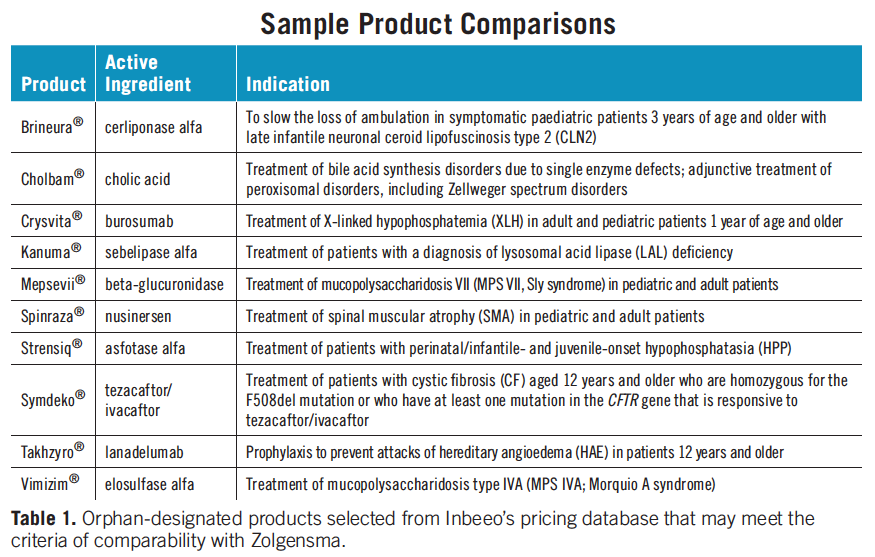Four Takeaways from the Zolgensma Pricing Storm
Pharmaceutical Executive
Four takeaway messages from the Zolgensma pricing storm
A case study of the changing cost climate driven by gene therapies
I’m sure by now everyone has seen the headlines:
"World’s most expensive therapy,” “astronomical,” “casino culture”
The May announcement by Novartis of the list price of its new gene therapy for spinal muscular atrophy (SMA), Zolgensma, sparked a plethora of heated reactions. $2.15 million was the figure. Now, a couple months later, it is time to look back at the story and try to answer one simple question: was this a storm in a teacup or a tropical cyclone?
Here are four takeaway messages from the drama that unfolded that may offer an answer.
1. Time is of the essence
The sticker-shock that stemmed from the Zolgensma list price reveal has eclipsed the question that really matters-the question of time. A 1, 2, 3, or 10 million-dollar investment doesn’t mean much if there is zero information regarding the timespan of the expected return. We have to state the obvious here that on one hand, it’s a gene therapy that is a one-time treatment requiring a considerable upfront investment, and on the other hand, there are a host of chronic therapies that require smaller investments spread over a period of time. Taken separately, those chronic treatments might seem more affordable, but cumulated over time, they can become far more expensive than Zolgensma’s single shot.
To me, the question of “for how long should those chronic treatment costs be cumulated to make a fair comparison between Zolgensma and the current standard of care?” trumps the question of the price tag. Novartis has opted for 10 years. In its press release, the company claimed that the set price was “50% below 10-year treatment costs for genetic pediatric ultra-rare diseases (estimated at $4.4 million to $5.7 million).” That could be considered a bit of a cryptic claim in the absence of information relating to the products included in the analysis. So, to that end, through mining Inbeeo’s pricing database, we extracted a sample of 10 products that might actually meet the criteria of comparability, including Biogen’s Spinraza, as the only other disease-modifying therapy approved in SMA (see Table 1).

We then estimated the cumulative treatment cost they would generate over different time periods (see Figure 1).
Click to enlarge

Broadly speaking, our analysis confirms Novartis’s claim of a 50% discount vs. other treatment costs for genetic pediatric rare diseases over 10 years. However, it also reveals that the variability of-and thus the uncertainty around-treatment costs grow considerably after 10 years. A five-year comparison seems more reasonable, with Zolgensma’s acquisition price being close to the median cost in our sample. Anything shorter than that puts Zolgensma under a less favorable light. This is why time is of the essence-a gene therapy price tag is only relevant in the context of how durable its benefit for the patient will be.
2. Cash doesn’t grow on trees
The question of the considerable upfront investment that will bring benefits over time is not a trivial one. In business, it is called “cash flow management,” and there are companies going bankrupt every day from doing it poorly.
Novartis has somewhat anticipated the issue by announcing the possibility to fund Zolgensma by installments. But installments are a mere payment convenience and payers will need more reassurance before making the decision to fund the product. Novartis anticipated that, too, and announced it was in advanced discussions with multiple payers to design outcomes-based contracting agreements. But with a thin evidence package, this promises to be quite the Herculean effort. Payers are not known for designing insurance schemes that might actually generate a loss for them-not to mention the cost of opportunity at a time when many more advanced therapies are expected.
3. Pricing communication is a thing
Mobile phone networks, energy providers, automakers, gyms, software developers, accounting firms, consultants, and many more have long understood this one key success factor in business: the way you communicate the price of your products is as important as their actual price level.
Paying as little as $5 for a power yoga class sounds like a wiser investment than a $2,000 annual gym membership that includes “all-you-can-eat” classes, and driving around town in the newest German car for $20 a day must be a bargain as compared to cutting a $40,000 check. They are the same product and at the end of the day will cost the customer the same amount of money, but the narrative affects the value perception-permanently. This is known as price anchoring, and it is pretty powerful. From the moment you have established a $2.15 million price anchor in the mind of your customers, it is difficult to move away from it.
4. No one is ready for what’s coming
With the not-so-great price anchoring, it is suggested here that Novartis was not fully prepared for the Zolgensma story. But who is? Surely not payers. Let’s take a look at the dominant pricing frameworks in the US and the EU and try and assess their level of readiness.
In the US, the dominant model remains utilization management via brand tier placement, using negative financial incentives to nudge patients and prescribers toward preferred brands and generics. Co-insurance continues to be on the rise, meaning it becomes customary to charge patients 10%, 20%, or more of the final bill.
The sums at play with Zolgensma are, of course, mind-boggling. And with pharma companies blaming insurers for not passing the negotiated rebates on to the consumer, you can be sure this issue will not go unnoticed with a treatment like Zolgensma. Copay cards will come in as short-term fixes, but they cannot hide the deficiencies of a system at risk of losing all connection to the reality of value.
In Europe, the dominant framework remains that of the incremental cost-effectiveness ratio (ICER). It is affected by some well-documented methodological issues, but if oversimplified to what may be the most acute ones, they
Study Methodology; click to enlarge

are two-fold. Firstly, the desire to summarize outcomes related to chronic disease in one universal measure-the quality-adjusted life year (QALY), which is something that is incredibly personal and individual. And, secondly, the way time and uncertainty are handled in cost-effectiveness models. Some recent product launches have clearly put those weaknesses in the spotlight, in particular in the orphan-drug space. But assessing the lifetime cost-effectiveness of a $2.15 million product based on two single-arm open-label studies of 35 patients combined promises to be quite the challenge. One can only imagine the dramatic effects of the sensitivity analyses when varying the proportion of patients being able to walk or sit thanks to the treatment, something that could possibly take the ICER down from several million to virtually zero.
Much to be written
It is clear that this is just the beginning of a story that is unfolding before our eyes, as confirmed by the recent list price disclosure of Zynteglo, Bluebird Bio’s gene therapy against transfusion-dependent beta-thalassemia. Claiming that Zolgensma is the most expensive treatment in the world is misleading. But claiming that the product is “expected to save costs to the healthcare system” in its approval press release is a leap of faith given how little we know about its long-term benefit-risk profile.
The only certainty is that pricing frameworks on both sides of the Atlantic need a profound change to be ready for gene and other advanced therapies. And by profound change, a reworking from the ground up, not applying Band-Aids through installments or ICER threshold modulations. With an estimated 10,000 currently known monogenic diseases according to the World Health Organization, the likes of Zolgensma and Zynteglo are prototypes of what payers are truly facing-not a few isolated storms, but an irreversible climate change.
Hervé Lilliu is Director, Inbeeo

Trump: 'Major Tariff' on Pharmaceuticals Coming Soon
Published: April 9th 2025 | Updated: April 9th 2025“We’re going to tariff our pharmaceuticals, and once we do that, they are going to come rushing back into our country," President Donald J. Trump said during a Tuesday night dinner in Washington.